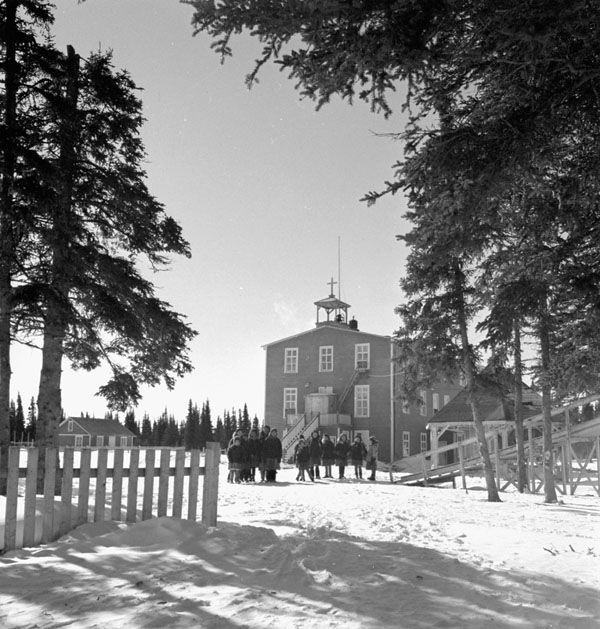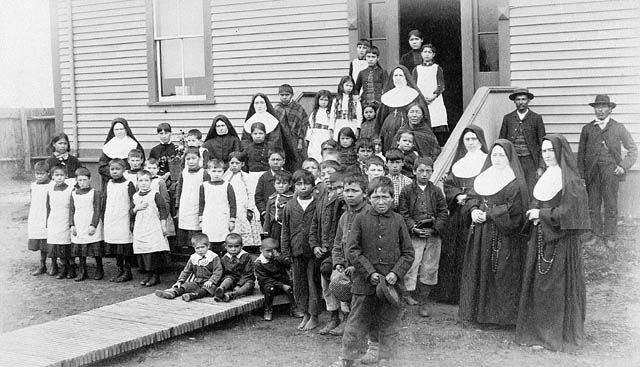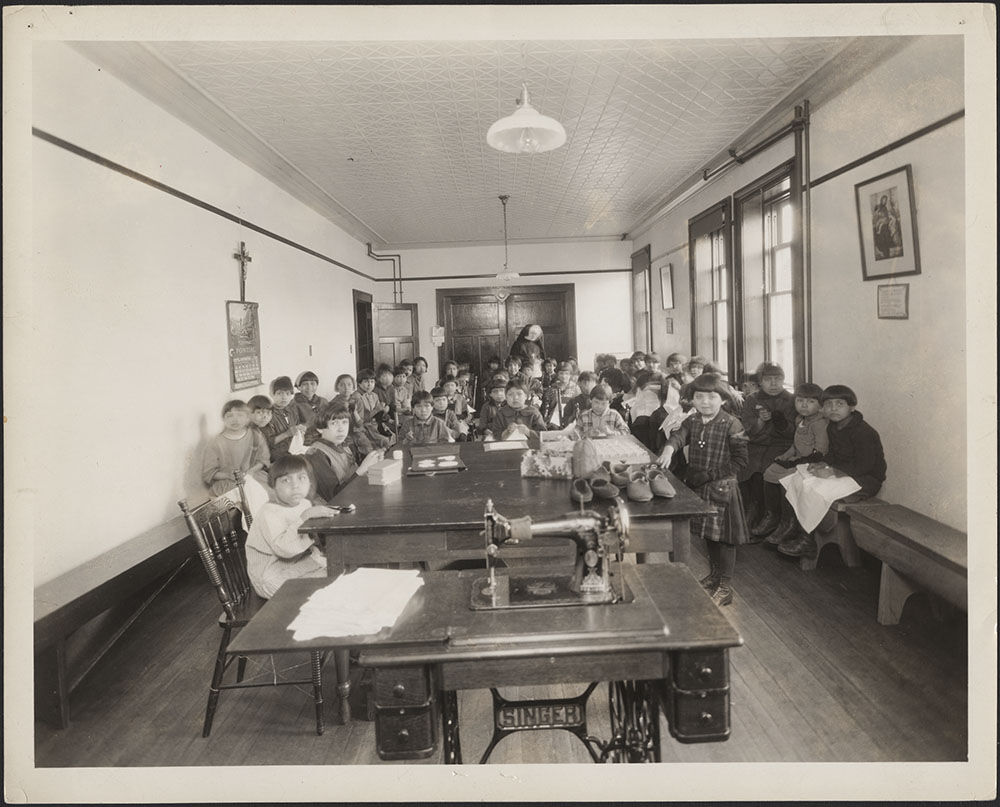Since colonization in Canada began, Europeans viewed Indigenous peoples as inferior. Early European missionaries and administrators decided to educate, evangelize and civilize Natives, to whom they referred to as “savages.”
Over the years, colonizers had a similar goal of forcing Indigenous peoples to assimilate. To achieve this goal, the federal government implemented various measures, including the Indian residential school system in Canada, which lasted from 1831 to 1996.
Forced Assimilation is when a dominant group seeks to integrate a minority group–a group who has less power–into its population by removing its distinctive character (culture, beliefs, languages, way of life).
The first residential school opened in Ontario in 1831. A few years after the Canadian federation was formed in 1867, the federal government funded the construction and operation of residential schools, but the Catholic, Anglican, United and Presbyterian churches were in charge of the education provided in the schools. These institutions were built across Canada, except in New Brunswick, Prince Edward Island and Newfoundland.
Indian Residential Schools in Canada
Source: Indian residential schools in Canada, 2012
The official purpose of these institutions was to educate Indigenous youth. In reality, it was a major campaign aimed at assimilating Indigenous peoples across Canada.

Oblates Missionary School at Fort George, Quebec in January 1946
Source: Missionary Oblates Indian Residential School Fort George, Quebec [Photograph], Glunz, Bud, 1946, Library and Archives Canada, (URL). Rights reserved*

Group of nuns with Indigenous students in Port Harrison, Quebec, circa 1890
Source: Groupe de religieuses et d’élèves autochtones [Photograph], Woodside, H.J., 1890, Library and Archives Canada, (URL). Rights reserved*
Young Indigenous people were taken from their families, sometimes by force, and placed in residential schools. The education they received there was intended to erase their culture by forcing them to learn about Canadian Christian culture. These young students were alienated from their culture since they had no contact with their family members: some of them only returned to their communities for a few months during the summer, while other children remained in residential schools for years.
Upon arriving at residential schools, children often received European names to replace their given names. Young Indigenous students learned French or English and were forbidden from using their native language, even among siblings or in letters to their families. The goal was to turn these Indigenous children into “proper Canadians.” In addition to teaching them one of the two official languages, the schools often forced them to practise Christianity, for example Catholicism or Protestantism, and to adopt Canadian culture in terms of their clothing, appearance and way of life. This included cutting the children’s hair short and removing all Native materials and cultural elements from their dress.

Mi’kmaq girls attending a sewing class at the Shubenacadie Indian Residential School in Nova Scotia, 1929
Source: Fillettes mi'kmaq suivant un cours de couture au pensionnat indien de Shubenacadie [Photograph], 1929, Library and Archives Canada, (URL). Rights reserved*
Control and authority was a priority in the schools in order to ensure forced assimilation, and punishment was common. Young Indigenous students were often subject to both mental and physical abuse, and sexual abuse was rarely punished. Living conditions in the residential schools were harsh and cold with widespread disease and malnutrition due to neglect.
In 1940, the Department of Indigenous Affairs decided to put an end to the residential school system and began gradually shutting them down, with the last boarding school closing its doors in 1996. Approximately 150 000 children attended these schools during the 165 years that they were open. It is difficult to know how many children died in the residential schools. So far, there have been 4134 confirmed deaths (CBC, 2013), but some estimate that as many as 6000 students may have died (Indian Residential Schools in Canada, 2012).
Indigenous cultures fragmented or were forgotten due to years of attempted assimilation. Some languages and customs were nearly lost because of residential schools. These schools left scars on Indigenous peoples and communities. Because of this, Indigenous communities and leaders lobbied for their rights to be recognized.
In 2008, the Truth and Reconciliation Commission of Canada (TRC) was tasked with documenting what went on inside residential schools across the country to inform the Canadian public. To do this, the commissioners and investigators met with and listened to residential school survivors, their families, communities and anyone else personally affected by residential schools. The TRC completed its mission in 2015 with the publication of several reports that are available on the National Centre for Truth and Reconciliation’s website.
The Commission also laid the groundwork for reconciliation and its 94 Calls to Action led to further action being taken. These actions included the National Inquiry into Missing and Murdered Indigenous Women and Girls, the results of which were published in 2019.
Pensionnats indiens au Canada. (2021, June 1st). L’encyclopédie canadienne. https://www.thecanadianencyclopedia.ca/fr/article/pensionnats
Bibliothèque et Archives Canada. (1929). Fillettes mi’kmaq suivant un cours de couture au pensionnat indien catholique de Shubenacadie, Nouvelle-Écosse [Photograph]. https://www.bac-lac.gc.ca/fra/recherchecollection/Pages/notice.aspx?app=FonAndCol&IdNumber=5159041*
Glunz, B. (1946). Pensionnat indien de la mission des Pères oblats. Fort George, Québec [Photograph]. Bibliothèque et Archives Canada. https://www.bac-lac.gc.ca/fra/recherchecollection/Pages/notice.aspx?app=fonandcol&IdNumber=4113891&new=-8585697120339551897.*
Radio-Canada. (2013, April 26). 4134 morts dans les pensionnats autochtones au Canada, https://ici.radio-canada.ca/nouvelle/610955/pensionnats-autochtones-morts
Woodside, H. J., (vers 1890). Groupe de religieuses et d’élèves autochtones [Photograph]. Bibliothèque et Archives Canada. https://www.bac-lac.gc.ca/fra/recherchecollection/Pages/notice.aspx?app=fonandcol&IdNumber=3624991&new=-8585781639414376806 *
* Excerpts used by Alloprof in accordance with the Copyright Act for fair use for educational purposes